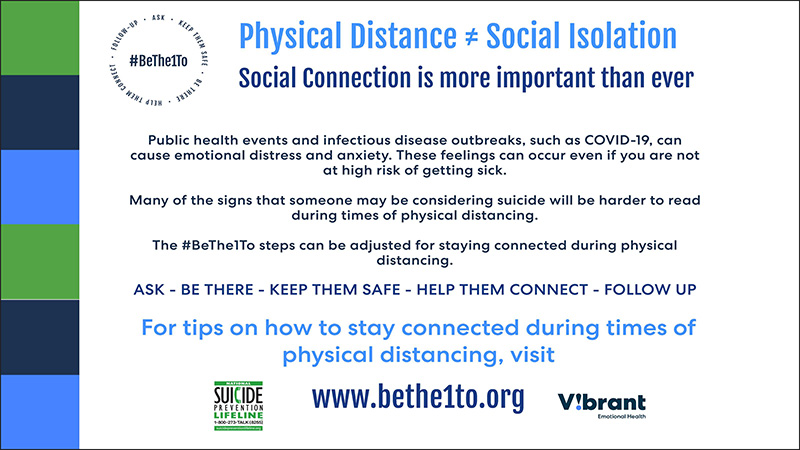While everyone is feeling challenged during COVID-19, it can be particularly difficult for those with existing mental health conditions or people who feel particularly lonely or isolated due to COVID-19. “Social distancing” recommendations, concerns about their own health and the health of loved ones, and the disruptions to services and everyday life, can increase levels of anxiety and distress. We prefer to use the term “physical distancing,” so we can underscore that social disconnection is in no way advisable in this public health crisis. In fact, socially connecting with others preserves mental health and resilience, and is essential for overall health during this stressful time when people cannot enjoy physically congregating in ways that were routine prior to the pandemic.

John Draper, PhD
At this time, we do not have any evidence that shows greater physical distancing is resulting in higher suicide rates. Nevertheless, U.S. national surveys are indicating that more people are feeling stress, anxiety and depression, and more are reporting thoughts of suicide when compared to this same time last year. As a result, we all need to be prepared to help ourselves and others cope through this challenging time. Some warning signs may help you determine if you are a loved one is at risk for suicide, especially if the behavior is new, has increased, or seems related to a painful event, loss, or change. Discerning these warning signs in others while maintaining physical distancing isn’t easy, so it may help to ask them and those who are living with them about these signs if you have some concerns about how they may be feeling, thinking or acting.
Physically distant behavior patterns that could suggest that you or someone you care about could be in emotional distress:
- Changes in tone, language, or time of day when texting, talking, or posting online
- Ignoring calls or texts;
- Changes in the frequency (more or less) and content of what they might be sharing online or if they share media links with you;
- Intentionally withdrawing socially because of a lack of belonging, fear, hurt, or perceived social rejection (not to be confused with maintaining physical distancing recommendations);
- Posting online or talking about feeling trapped, hopeless, a burden to others, or being in unbearable pain.
Noticeable physical changes may be a reason to check in, such as:
- significant change in energy level or appetite;
- increased use of drugs or alcohol;
- extreme mood swings;
- sleeping too much or too little;
- frequent headaches, stomachaches, or body pains;
- heightened worrying or anxiety; or
- inability to take pleasure in activities that were once enjoyable.
If you’re concerned about someone in your life that may be in suicidal crisis, Vibrant Emotional Health, administrators of the National Suicide Prevention Lifeline, have created five steps to help. The five #BeThe1To steps are simple actions everyone can take to help reduce emotional distress and potentially prevent suicide. These steps are derived from research and applied training for crisis counselors in the Lifeline network, and provide some very basic, fundamental tips about caring for others who are in crisis. During National Suicide Prevention Month in September and beyond, sharing these steps and raising awareness of the ways that people can stay socially connected while being physically distant can help empower us all to support each other through crisis and emotional distress. While #BeThe1To has been an active public health message since 2015, Vibrant Emotional Health has adapted the steps for COVID-19 and physical distancing.
The #BeThe1To Steps
ASK: Asking the question “Are you thinking about suicide?” communicates that you’re open to speaking about suicide in a non-judgmental and supportive way. Asking in this direct, unbiased manner can open the door for effective dialogue about their emotional pain and next steps. Research has shown that asking this question neither “puts the idea in someone’s head,” nor does it offend; people feeling suicidal are relieved that you care enough to ask the question. One can introduce the question after sharing your concern about how they have been feeling, and how the losses or stresses they have reported to you are affecting them. During times of physical distancing, in addition to being generally alert for potential risk in all loved ones, it is useful to pay special attention to people that already struggle or have struggled in the past with emotional distress. Make sure to reach out more frequently to talk and check in and don’t wait for them to come to you to ask for help or connection. Helping people stay connected can help to prevent people from thinking about or acting on thoughts of suicide.
BE THERE: For many, being alone is not the same as feeling alone. Feeling alone is feeling as if no one cares about you or values you. How can you show a person who may be feeling “not cared about” that you care for them, if you can’t go see them? While being physically present may not be an option right now, there are still many other ways to be there for someone, including speaking with them on the phone/video phone, by text, through various online platforms. Make a list of people whom you would like to connect with regularly—including ones who support you (and can make you smile or laugh) as well as those whom you’d like to support—and try to reach out to one per day. The important things to keep in mind when maintaining social connection through distance are the regularity and quality of the connection. Establish the frequency in which the person would like you to check in with them, and then stick to that schedule. When talking on the phone or video calling with them, be present, non-judgmental, and listen. Remove distractions so that you can focus on your conversation. You can also plan to engage in fun activities together, either virtually or—if you both have been safely sheltered—for a time when you can be physically present together.
KEEP THEM SAFE: If you ask someone if they are thinking about suicide and they say yes, you can keep them safe and separate them from anything they are thinking of using to hurt themselves. Even while being physically distanced, take steps to put time and space between the person and items they may use to hurt themselves. You can use these questions/prompts to encourage the person to distance themselves from the means:
- If they have stated that they have the means for hurting or killing themselves, let them know how much you care about them and how important it is to you that they remain safe. Be honest with them about the gravity of your concern and talk with them directly about what they could do to make it harder for them to access those means in a crisis, when they might be more inclined to act impulsively. If the person has the means in hand while you are talking to them, ask if they could put it away from them while you talk. Call the Lifeline
- After you talk, ask the person to think about the overall safety of their environment. Is there anything else in their home, like firearms, that should be protected against to put more time and space between them and the potential means, even if those means of self-harm weren’t the person’s first intended plan? If others whom they trust live with or near them, ask if they can be included in helping to keep them safe.
HELP THEM CONNECT: Helping people connect with other services that can support them is still possible while staying physically distant. Developing a safety plan is an important step and can be done through the My3 app. The Lifeline (800-273-8255) is another great option during times of distance – trained counselors are available to call or chat 24 hours a day, seven days a week, and 365 days a year. Another option is to connect to a tele-mental health provider that can provide regular and consistent support from a mental health professional.
For people that may not be ready to connect with a counselor or mental health provider, the Vibrant Safe Space website is home to resources and tools to provide you with choices of digital support in an emotionally safe environment. If others whom the person trusts are living with them, can safely visit, or be included in providing calls/texts/virtual screen meetings to check in and support them, it is important to generate a list of these people and contact them. Creating a circle of support—including both formal helping resources and friends/family—will be vital to keep the two of you from dealing with this crisis alone.
FOLLOW UP: Never underestimate the value of showing up. Following up provides the person with a further feeling of connectedness. Similar to the principles of ‘be there’ during physical distancing, setting aside a time and date that you will follow up with a person in crisis can provide something to look forward to and sends the message that you care, and that they remain on your mind. Determine a time that works best for the two of you to check in regularly for a few days and/or weeks after. You can also send texts, notes, emails or whatever the person most readily responds to. When you are scheduled to connect—and eventually do connect—be sure to clear your calendar of all distractions for the time.
The National Suicide Prevention Lifeline and Vibrant Emotional Health are sharing the five #BeThe1To steps, as well as other resources and events, throughout September for Suicide Prevention Month. We welcome participation and collaboration from the public and other organizations in the mental health field. Message kits, graphics, resources, and events for September can be found at bethe1to.com. Find out more about the National Suicide Prevention Lifeline www.suicidepreventionlifeline.org.
John Draper, PhD, is Executive Director of the National Suicide Prevention Lifeline and Executive Vice President of National Networks at Vibrant Emotional Health.







